
Kingston upon Thames is a town in the Royal Borough of Kingston upon Thames, South West London, England. It is situated on the River Thames and 10 miles (16 km) southwest of Charing Cross. It is notable as the ancient market town in which Saxon kings were crowned and today is the administrative centre of the Royal Borough.
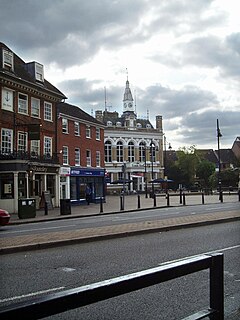
Staines-upon-Thames is a town on the left bank of the River Thames in Surrey, England, in the borough of Spelthorne. At or near the Roman settlement of Pontibus, it became Stanes and then Staines. Its borough is in the historic county of Middlesex and its two precursor districts were transferred to Surrey County Council in 1965.

Surrey is a county in South East England which borders Kent to the east, East Sussex to the southeast, West Sussex to the south, Hampshire to the west, Berkshire to the northwest, and Greater London to the northeast. With about 1.2 million people, Surrey is the 12th-most populous English county, the third-most populous home county, after Kent and Essex, and the third-most populous in the Southeast, after Hampshire and Kent.

The Royal Borough of Kingston upon Thames is a borough in southwest London. The main town is Kingston upon Thames and it includes Surbiton, Chessington, Malden Rushett, New Malden and Tolworth. It is the oldest of the four royal boroughs in England. The others are Kensington and Chelsea and Greenwich also in London, and Windsor and Maidenhead. The local authority is Kingston upon Thames London Borough Council.

Norbiton is an area within the Royal Borough of Kingston upon Thames, London. It lies approximately 1 mile (1.6 km) east of Kingston upon Thames town centre, and 11 miles (17.7 km) from Charing Cross. Its main landmarks include Kingston Hospital, Kingsmeadow football stadium, Kingston Cemetery and St Peter's Anglican parish church which serves the area.
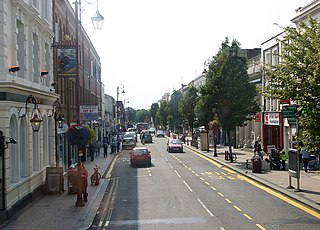
Surbiton is a suburban neighbourhood in South West London, within the Royal Borough of Kingston upon Thames (RBK). It is next to the River Thames, 11 miles (18 km) southwest of Charing Cross. Surbiton was in the historic county of Surrey and since 1965 it has been in Greater London. Surbiton comprises four of the RBK's wards: Alexandra, Berrylands, St. Mark's, and Surbiton Hill.
Richmond is a town in south-west London, 8.2 miles (13.2 km) west-southwest of Charing Cross. It is on a meander of the River Thames, with many parks and open spaces, including Richmond Park, and many protected conservation areas, which include much of Richmond Hill. A specific Act of Parliament protects the scenic view of the River Thames from Richmond.

Elmbridge is a local government district with borough status in Surrey, England. Its principal towns and villages are Esher, Cobham, Walton-on-Thames, Weybridge and Molesey. It directly borders the London Borough of Richmond upon Thames and the London Royal Borough of Kingston upon Thames. Some areas of the borough form a continuation of the Greater London Built-up Area, formerly falling into the Metropolitan Police District.

Walton-on-Thames, locally known as Walton, is a market town on the south bank of the Thames in the Elmbridge borough of Surrey, England. Walton forms part of the Greater London built-up area, within the KT postcode and is served by a wide range of transport links. According to the 2011 Census, the town has a total population of 22,834. The town itself consists mostly of affluent suburban streets, with a historic town centre of Celtic origin. It is one of the largest towns in the Elmbridge borough, alongside Weybridge.
Maurice Everett Webb (1880–1939) was an English architect of the early 20th century, who started his architectural career working for his famous architect father, Sir Aston Webb, the practice trading as Sir Aston Webb and Son for some years. He was the first chairman of the Building Centre in London.
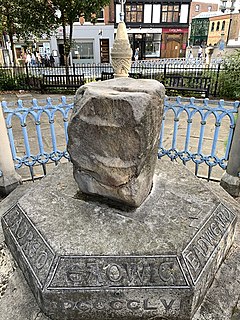
The Coronation Stone is an ancient sarsen stone block which is believed to have been the site of the coronation of seven Anglo-Saxon kings. It is presently located next to the Guildhall in Kingston upon Thames, England. Kingston is now a town in the Royal Borough of Kingston Upon Thames in Greater London.
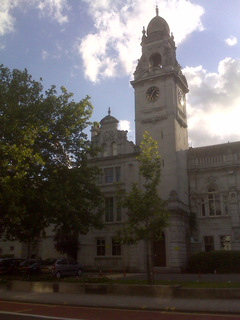
County Hall is a former municipal building in Penrhyn Road, Kingston upon Thames, England. The building, which was the headquarters of Surrey County Council from 1893 to 2020, is a landmark in Kingston and is a Grade II listed building.

Exeter Guildhall on the High Street of Exeter, Devon, England has been the centre of civic government for the city for at least 600 years. Much of the fabric of the building is medieval, though the elaborate frontage was added in the 1590s and the interior was extensively restored in the 19th century. It is a Grade I listed building.

Kingston London Borough Council is the local authority for the Royal Borough of Kingston upon Thames in Greater London, England. It is a London borough council, one of 32 in the United Kingdom capital of London.

The Old Town Hall, Richmond on Whittaker Avenue in Richmond, London is a former municipal building which from 1893 to 1965 served as the town hall for the Municipal Borough of Richmond.

Kingston upon Thames War Memorial, in the Memorial Garden on Union Street, Kingston upon Thames, London, commemorates the men of the town who died in the First World War. After 1945, the memorial was updated to recognise casualties from the Second World War. The memorial was commissioned by the town council and was designed by the British sculptor Richard Reginald Goulden. The memorial includes a bronze statue of a nude warrior, carrying a flaming cross and wielding a sword with which he defends two children from a serpent, erected on a granite plinth, with bronze plaques listing the names of the dead. Goulden designed a number of such allegorical memorials, including others at Crompton, Greater Manchester, and Redhill, Surrey. The Kingston memorial was designated a Grade II listed structure in 1983. This was revised upwards in 2016 to Grade II*, denoting a building or structure of particular importance.

The Sessions House is a municipal building in Ewell Road, Surbiton, London. It is a Grade II listed building.
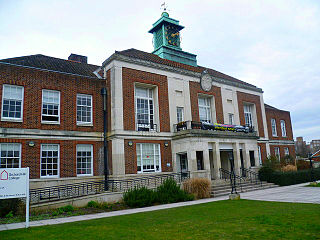
Wallington Town Hall is a municipal building in Woodcote Road, Wallington, London. It is a Grade II listed building.



















